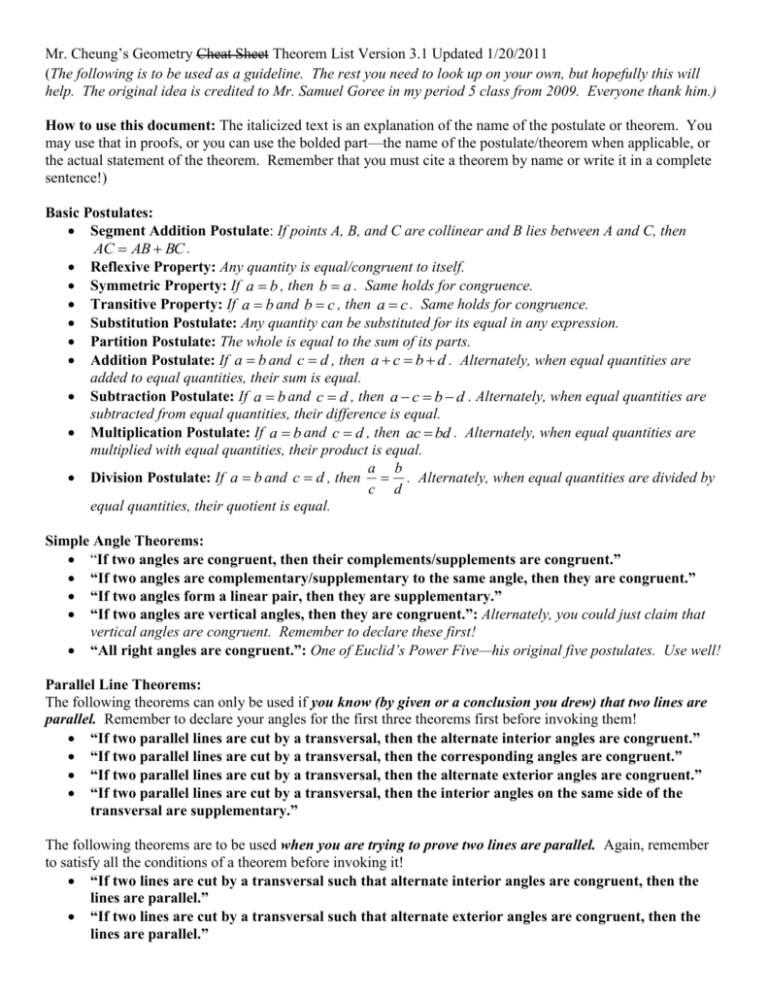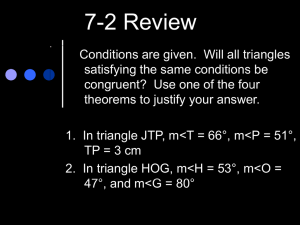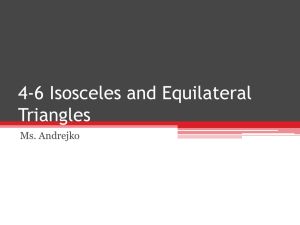Theorem Sheet
advertisement

Mr. Cheung’s Geometry Cheat Sheet Theorem List Version 3.1 Updated 1/20/2011 (The following is to be used as a guideline. The rest you need to look up on your own, but hopefully this will help. The original idea is credited to Mr. Samuel Goree in my period 5 class from 2009. Everyone thank him.) How to use this document: The italicized text is an explanation of the name of the postulate or theorem. You may use that in proofs, or you can use the bolded part—the name of the postulate/theorem when applicable, or the actual statement of the theorem. Remember that you must cite a theorem by name or write it in a complete sentence!) Basic Postulates: Segment Addition Postulate: If points A, B, and C are collinear and B lies between A and C, then AC AB BC . Reflexive Property: Any quantity is equal/congruent to itself. Symmetric Property: If a b , then b a . Same holds for congruence. Transitive Property: If a b and b c , then a c . Same holds for congruence. Substitution Postulate: Any quantity can be substituted for its equal in any expression. Partition Postulate: The whole is equal to the sum of its parts. Addition Postulate: If a b and c d , then a c b d . Alternately, when equal quantities are added to equal quantities, their sum is equal. Subtraction Postulate: If a b and c d , then a c b d . Alternately, when equal quantities are subtracted from equal quantities, their difference is equal. Multiplication Postulate: If a b and c d , then ac bd . Alternately, when equal quantities are multiplied with equal quantities, their product is equal. a b Division Postulate: If a b and c d , then . Alternately, when equal quantities are divided by c d equal quantities, their quotient is equal. Simple Angle Theorems: “If two angles are congruent, then their complements/supplements are congruent.” “If two angles are complementary/supplementary to the same angle, then they are congruent.” “If two angles form a linear pair, then they are supplementary.” “If two angles are vertical angles, then they are congruent.”: Alternately, you could just claim that vertical angles are congruent. Remember to declare these first! “All right angles are congruent.”: One of Euclid’s Power Five—his original five postulates. Use well! Parallel Line Theorems: The following theorems can only be used if you know (by given or a conclusion you drew) that two lines are parallel. Remember to declare your angles for the first three theorems first before invoking them! “If two parallel lines are cut by a transversal, then the alternate interior angles are congruent.” “If two parallel lines are cut by a transversal, then the corresponding angles are congruent.” “If two parallel lines are cut by a transversal, then the alternate exterior angles are congruent.” “If two parallel lines are cut by a transversal, then the interior angles on the same side of the transversal are supplementary.” The following theorems are to be used when you are trying to prove two lines are parallel. Again, remember to satisfy all the conditions of a theorem before invoking it! “If two lines are cut by a transversal such that alternate interior angles are congruent, then the lines are parallel.” “If two lines are cut by a transversal such that alternate exterior angles are congruent, then the lines are parallel.” “If two lines are cut by a transversal such that corresponding angles are congruent, then the lines are parallel.” The following theorems about parallel lines are miscellaneous. “If two lines are perpendicular to the same line, then the lines are parallel.” “If a line is perpendicular to one of two parallel lines, then it is perpendicular to the other.” Euclid’s Fifth Postulate: Through a given point not on a given line, there exist exactly one line that can be drawn through the point parallel to the given line. Triangle Congruence Theorems The following are the only ways of proving triangles are congruent. SSS Postulate: Three pairs of corresponding sides are congruent. SAS Postulate: Two pairs of corresponding sides and the angle included (between) the sides are congruent. Make sure that the angle is between the sides! ASA Postulate: Two pairs of corresponding angles and the side included (between) the angles are congruent. Make sure that the side is between the angles! AAS Theorem: Two pairs of corresponding angles and a corresponding pair of sides opposite one of these angles are congruent. Make sure that the side is NOT between the angles! Hyp-Leg Theorem: In a right triangle, a pair of hypotenuses and a pair of corresponding legs are congruent. Make sure that the triangle is a right triangle, and declare this first! “Corresponding parts of congruent triangles are congruent.”: Do NOT abbreviate this! Write it out. Isosceles Triangle Theorems: “If two angles in a triangle are congruent, then the triangle is isosceles.” “If two sides in a triangle are congruent, then the triangle is isosceles.” “If two angles in a triangle are congruent, then the sides opposite them are congruent.” “If two sides in a triangle are congruent, then the angles opposite them are congruent.” “If a triangle is equiangular, then it is equilateral.” “If a triangle is equilateral, then it is equiangular.” Equidistance Theorems: “If a point lies on the perpendicular bisector of a line segment, then it is equidistant from the endpoints of the line segment.” “If a point is equidistant from two points, then it lies on the perpendicular bisector of the line segment.” “If a point lies on an angle bisector, then it is equidistant from the sides of that angle.” “If a point is equidistant from the sides of an angle, then it lies on the angle’s bisector.” Inequality Postulates/Theorems “The whole is greater than any of its parts.” The Trichotomy Postulate: “Given two numbers, a and b, exactly one of the following is true—a > b, a< b, or a = b. Transitive Property: “If a > b and b > c, then a > c.” The Addition Postulate of Inequality: “If a b and c d , then a c b d . The same is true if the signs are reversed. The Subtraction Postulate of Inequality: “If a b and c d , then a c b d . The same is true if the signs are reversed. The Multiplication Postulate of Inequality: If a b and c 0 , then ac bc . Similarly, if a b and c 0 , then ac bc . The Triangle Inequality: “The sum of the lengths of two sides of a triangle is greater than that of the third.” “The measure of an exterior angle of a triangle is greater than the measure of either of the two remote interior angles.” “If the lengths of two sides of a triangle are unequal, then the larger angle is opposite the longer side, and vice versa.” “If the measures of two angles of a triangle are unequal, then the longer side is opposite the larger angle, and vice versa.” Quadrilaterals: 1) The Parallelogram Properties: Opposite sides of a parallelogram are parallel. Opposite sides of a parallelogram are congruent. Opposite angles of a parallelogram are congruent. Consecutive angles of a parallelogram are supplementary. A diagonal divides a parallelogram into two congruent triangles. The diagonals of a parallelogram bisect each other. The following theorems are to be used to show a quadrilateral is a parallelogram. “If a quadrilateral has two pairs of opposite parallel sides, then it is a parallelogram.” “If a quadrilateral has two pairs of opposite congruent sides, then it is a parallelogram.” “If a quadrilateral has two pairs of opposite congruent angles, then it is a parallelogram.” “If a quadrilateral has one pair of opposite, parallel, and congruent sides, then it is a parallelogram.” “If a quadrilateral has diagonals that bisect each other, then it is a parallelogram.” 2) The Rectangle Properties: Has all properties of the parallelogram. All angles in a rectangle are right angles. All angles in a rectangle are congruent. The diagonals of a rectangle are congruent. The following theorems are to be used to show a quadrilateral is a rectangle. Make sure to show that the quadrilateral is a parallelogram first! “If a parallelogram has a right angle, then it is a rectangle.” “If a parallelogram has congruent diagonals, then it is a rectangle.” 3) The Rhombus Properties: Has all properties of a parallelogram. All sides of a rhombus are congruent. The diagonals of a rhombus are perpendicular. The diagonals of a rhombus bisect its angles. The following theorems are to be used to show a quadrilateral is a rhombus. Make sure to show that the quadrilateral is a parallelogram first! “If a parallelogram has two congruent consecutive sides, then it is a rhombus.” “If a parallelogram has perpendicular diagonals, then it is a rhombus.” “If a parallelogram has a diagonal that bisects two opposite angles, then it is a rhombus.” 4) The Square Properties: Has all properties of a rhombus. Has all properties of a rectangle. The following theorems are to be used to show a quadrilateral is a square. “If a rectangle has a pair of congruent consecutive sides, then it is a square.” “If a rhombus has a right angle, then it is a square.” 5) The Trapezoid Properties: A trapezoid has exactly one pair of parallel sides. 6) The Isosceles Trapezoid Properties: Has all properties of a trapezoid. The diagonals of an isosceles trapezoid are congruent. The base angles of an isosceles trapezoid are congruent. The legs of an isosceles trapezoid are congruent. The following theorems are to be used to show a trapezoid is an isosceles trapezoid. “If a trapezoid has congruent legs, then it is isosceles.” “If a trapezoid has congruent base angles, then it is isosceles.” “If a trapezoid has congruent diagonals, then it is isosceles.” Miscellanea: “If two lines intersect to form congruent adjacent angles, then the lines are perpendicular.” “The segment that joins the midpoints of two sides of a triangle is parallel to the third side and is half as long as that side.” (This is the Triangle Midline Theorem.)








